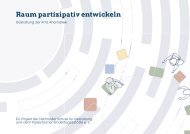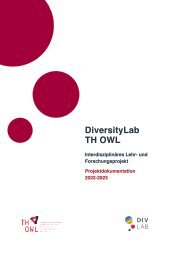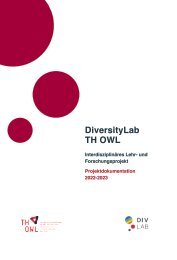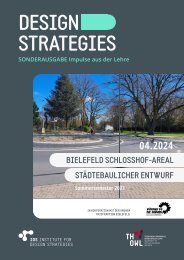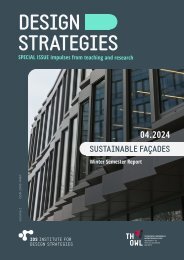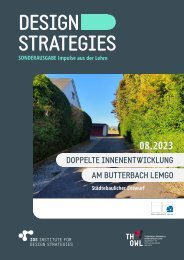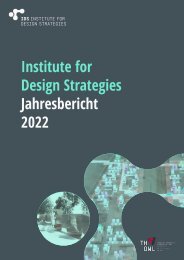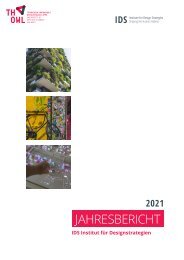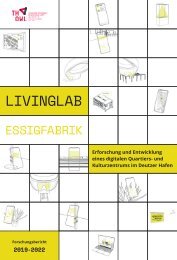urbanLab Magazin 2021 - Transformation
Sie wollen auch ein ePaper? Erhöhen Sie die Reichweite Ihrer Titel.
YUMPU macht aus Druck-PDFs automatisch weboptimierte ePaper, die Google liebt.
'protection mechanisms with regards<br />
to the specific sound perception of individuals.<br />
UPDATE / UPGRADE / MAINTENANCE<br />
Fig. 4: The development of well-defined intersections is essential for<br />
fast and easy replacement of components<br />
Window with Active Noise Controlling”.<br />
The aim of the research (Suh, 2017),<br />
was to developed a window with very<br />
good sound reduction properties in<br />
an open position. To meet this goal several<br />
components are combined and<br />
inter-connected: A sensor is installed<br />
to control the noise level outside the<br />
building. When the noise level reaches<br />
a defined level, an active noise control<br />
(ANC) mechanism installed in the vent<br />
frame, produces a frequency dependent<br />
counter sound that balances the<br />
noise transferred to the interior. If the<br />
outside noise level is too high to get<br />
balanced by ANC, the sensor gives an<br />
impulse to the motor interface of the<br />
window and the vent frame gets automatically<br />
closed. If the outer noise level<br />
decreases again, the window opens automatically<br />
with the help of the motor<br />
interface. The sensor used for the above<br />
mentioned ANC-window measures<br />
the general interior noise level. Some<br />
research institutes are already investigating<br />
the potential of so called “wearable”<br />
or “embedables” that for example<br />
can be installed in the ear or embedded<br />
under the skin. These new kind of<br />
sensors can be used to measure the<br />
stress level of individuals and can recognize<br />
why the stress occurs. It can be<br />
imagined as a futuristic sensor in the<br />
ANC-window that controls the noise<br />
W. Heusler<br />
As explained above, modern adaptive<br />
façade products become more complex<br />
with a wide variety of components.<br />
The mentioned ANC-window installed<br />
in an aluminum façade is an example<br />
construction with various components<br />
that differ in their life expectations and<br />
innovation cycles. The aluminum facade<br />
has a predicted life expectancy of<br />
approximately 30 years, appropriate<br />
maintenance presumed. The sensor<br />
interface of the ANC-window might be<br />
a first edition of a high-tech product<br />
with an innovation cycle of 10 years or<br />
less. Furthermore, the sensor interface<br />
is susceptible to interferences, due<br />
to missing long-term experience. Without<br />
a well-defined intersection between<br />
the façade and the ANC-window<br />
an individual exchange of the single<br />
components and with this an update<br />
or upgrade of the entire facade is<br />
hardly possible. With regards to sustainability<br />
aspects, the just explained<br />
well-defined intersection between the<br />
different components of a façade that<br />
enables a fast and easy replacement is<br />
vital (Figure 4). Furthermore, a specific<br />
maintenance and upgrading plan for<br />
the façade with all its components has<br />
to be created that must be easily accessible<br />
throughout the complete product<br />
life span. Technologies like radio<br />
frequency identification (RFID) or near-field<br />
communication (NFC) can assist<br />
here with data management already<br />
visible in the global facade business<br />
(Lothar, 2019). Another digital technology<br />
that takes part in the maintenance<br />
of facades is the use of robots for façade<br />
cleaning purposes. Although the<br />
cleaning of highrise-building facades<br />
in the past and even today was mostly<br />
done by humans, modern companies<br />
already offer solutions with robots that<br />
provide a very effective cleaning method<br />
with the possibility for individual<br />
cleaning intervals.<br />
118 DATA DRIVEN DESIGN






